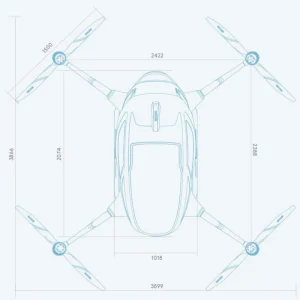All eVTOL aircraft are very sophisticated machines that rely on several key parts to operate efficiently. Let’s see what the main components of eVTOL aircraft are and what their function is.

The Main Components of eVTOLs
These are in a very schematic way all major eVTOL components. Each of the manufacturers then has their own models with different features. In any case, the choice of materials and technologies remains mainly common to each model.
Electric Motors
These motors, generally numerous and evenly distributed throughout the structure, provide the necessary thrust for vertical takeoff and horizontal flight. The power output of these motors can vary widely depending on the specific design of the eVTOL. Usually is in the range of a few hundred kW.
Power consumption is equally variable, depending on the aircraft model, its weight, speed, and type of flight (vertical or horizontal). However, the main objective in designing electric motors for eVTOLs is to optimize energy efficiency in order to maximize flight range. You can see an article on the leading manufacturer of electric motors for eVTOL.
Batteries
High-capacity batteries are critical components of eVTOLs. They are usually lithium-ion because of their energy density (2000 W/kg) and power-to-weight ratio. These batteries can store a large amount of energy in a small space, making them ideal for use in aircraft that require minimal weight for optimal operation.
Lithium-ion batteries have a long service life, which means they can provide a large amount of energy for extended periods. The specific capacity of the batteries varies depending on the size and design of the eVTOL, with some models capable of supporting flights lasting more than an hour.
Flight Control System
The sophisticated flight control system manages all the complex operations of eVTOLs. This system includes sensors, processors, and software that regulate the flight, stability, and control of the aircraft. Sensors constantly monitor a variety of parameters, including speed, altitude and orientation, while processors interpret this information and give precise instructions to the control systems.
Takeoff and landing maneuvers in automatic mode are also implemented. Built-in software provides an intuitive user interface, allowing pilots to monitor and control the aircraft efficiently.
Propellers or Rotors
The propellers or rotors of an eVTOL are distinct in their design and functionality. They are typically smaller in size, which allows for a higher number of rotors without significantly increasing the overall size of the aircraft. The multi-rotor configuration not only enhances stability and control but also improves safety, as the failure of a single rotor can often be compensated for by the others.
In some designs, the rotors or propellers can tilt or rotate to transition between vertical and horizontal flight, making them versatile in different flight conditions. Additionally, eVTOL rotors often feature a ducted design for improved efficiency and noise reduction.
Airframe Structure
eVTOL vehicles necessitate a unique approach to airframe structure design. With the need to carry out vertical takeoffs and landings, the airframe must incorporate specialized components such as distributed electric propulsion systems. Lightweight materials like carbon fiber composites are often utilized to minimize weight while offering superior strength and rigidity.
The airframe must also be designed to accommodate batteries or other power sources, adding an additional layer of complexity to the design process. Ultimately, the optimal eVTOL airframe structure is a blend of strength, lightweight, and aerodynamic efficiency, facilitating safe and efficient flight.
Avionics and Electronics
The sophisticated avionics and electronic systems on an eVTOL are the beating heart of the machine. These manage the aircraft’s communication, navigation, and control systems. Avionics include high-precision navigation instruments that make reliable flights possible even in adverse weather conditions or in complex geographic areas.
Sensors provide constant monitoring of flight conditions and aircraft operation, ensuring safety and efficiency. Communication devices enable continuous and timely interaction with ground control stations and other aircraft, which is essential for normal operations and to handle any emergencies.
And speaking of software, it is a must to mention the VoloIQ system, the first capable of managing the entire local traffic of eVTOL aircraft.
Redundancy Systems of eVTOL Components
In an eVTOL, as in any aircraft, redundancy systems are critical safety elements. These backup systems may include additional motors, alternative power sources, or duplicate control systems. The goal of these measures is to ensure the continuous operation of the eVTOL even if any of its major components fail. This functional redundancy reduces the risk of accidents, thereby increasing the safety of air passages.
Energy Management Systems
The Energy Management Systems of an eVTOL primarily focus on regulating and optimizing the distribution and consumption of energy across various subsystems of the aircraft. These systems ensure the most efficient use of the stored energy from the batteries, thereby increasing the flight range and duration.
They monitor and control the charging and discharging of batteries, manage power distribution during different flight phases, and help in maintaining the overall health and longevity of the battery. Moreover, these systems can also provide real-time data to the pilot, helping them make informed decisions regarding energy usage during the flight.
Safety and Emergency Systems
Safety and emergency systems of an eVTOL are designed to minimize risks during flight. They include multiple aspects, such as autopilot redundancy and fail-safe systems. They ensure that the impact of any technical problems to the vehicle’s primary systems is reduced. Automated emergency landing systems are also in place which can identify a safe place for an emergency landing.
Additionally, they may also incorporate systems that deploy parachutes to ensure a safe descent in case of catastrophic failure. Some eVTOLs also include fire suppression systems and emergency exit designs to allow rapid egress if needed.
FAQ
Why do EVTOLs have so many propellers?
An eVTOL employs multiple propellers rather than a single one. These propellers are engineered to redistribute power among the remaining ones in case of motor failure. Electric motors, having fewer components compared to gas turbine or combustion engines, offer the prospect of reduced maintenance expenses.
What batteries do eVTOLs use?
Due to their high energy density, lithium-ion batteries enable eVTOLs to store substantial electrical charge, resulting in extended flight ranges and reduced reliance on frequent recharging.
What is the voltage of eVTOL?
In contrast to small-scale UAVs, eVTOLs demand heavier loads and elevated battery needs, requiring voltages exceeding 100 volts and currents ranging from 100 to 300 amperes.

